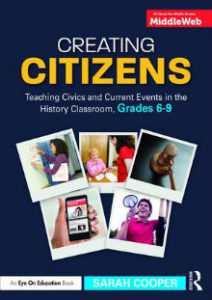An Op-Ed Project Based on Personal Choice
A MiddleWeb Blog
 Assigning opinion pieces on current issues gives our students voice and lets us hear their strong and sometimes fiery perspectives.
Assigning opinion pieces on current issues gives our students voice and lets us hear their strong and sometimes fiery perspectives.
When I’ve assigned op-eds in both world and U.S. history, students have responded best when they have wide latitude to choose a topic, picking something to which they feel a personal connection. They do research, but it’s not overwhelming. They keep their opinion pieces short: 450 words maximum. And they write for two built-in authentic audiences: their peers and our school newspaper.
With any project, I give students a brief written rationale. For this assignment, it read:
In order to apply your curiosity and news-reading skills to a meaningful piece of research and writing, we will be doing an op-ed project. An op-ed is a short opinion piece that appears in the editorial (opinion) section of a newspaper or magazine. Understanding how strong op-ed pieces are written is key to becoming a media-literate, global citizen. By the end of the project, you will have looked at models of strong opinion writing, expressed your opinion thoughtfully on an issue you care about, and read and commented on a number of your classmates’ pieces.
Some of the inspiration and details of the project, especially the word count, came from the New York Times’ Annual Student Editorial Contest. The site gives superb pithy guidance for how to write an opinion piece that is not clichéd, including this rubric and video.
To help with topic selection, I encouraged students to be as detailed as possible, telling them to “decide on a topic you care about. It should be something that has a connection to U.S. local, national or international policy and/or has political implications (as many topics do). It should also be specific—not simply ‘immigration’ but ‘the consequences of allowing undocumented immigrants in California to have driver’s licenses,’ for instance.”
The assignments and handouts
To give students an idea of the tone and structure of strong opinion pieces, we usually take a day in the library for them to browse through helpful sites, with directions such as these:
1. Read through at least three opinion pieces from three different places: the opinion pages of
• the New York Times
• the Washington Post
• the Wall Street Journal
• the Los Angeles Times
AND/OR
• Read through at least three opinion pieces from three different places: the opinion pages of the top 10 student editorial contest winners from last year’s New York Times student essay contest.
2. For each piece, write down:
• Headline, in quotes
• Source
• A quotation you like from the piece
• A sentence about something the piece does effectively in terms of writing style or structure
Most students finished browsing in class, and anything they didn’t finish became homework. This assignment functioned in two helpful ways: exposing students to the kinds of topics that people write op-eds about and showing them the power of a tight structure, with a powerful hook, a strong argument, illustrative quotations, and constructive counterarguments.
Here’s a handout I gave them to help them narrow the options on their own:
Deciding on a Topic for Your Op-Ed
Begin thinking about a topic you might enjoy writing about for your op-ed. It should be something that has a connection to U.S. local, national or international policy and/or has political implications (as many topics do). To think of topics, feel free to:
- Look through the current events articles you have brought in on Fridays so far this year. Do you see patterns? Are there topics you would like to explore further?
- Look through the New York Times’ Student Editorial Contest Finalists and see if any of those topics spark new ideas.
- Browse the topics on this site, 192 Questions for Writing or Discussion.
- Talk to your parents, friends or other adults about interesting topics.
Due in two days:
- Write 100+ words on a topic or topics you would like to research in the library on Wednesday and possibly write about for your op-ed. If you’d like to do research before then, feel free to print out any relevant articles on your topic.
- List at least five different phrases you could look for, relating to your topic, when you search the library’s databases or the free web on Wednesday in class.
⇒ THE MORE SPECIFIC, THE BETTER. For instance, searching for “illegal immigration” is way too broad. Searching for “stopping illegal immigration from Central America” or “minimum wage for farmworkers in California” has the necessary level of detail.
Download: Deciding on a Topic for Your Op-Ed
Once the eighth graders found two sources on our school’s databases or the free web and did a quick Works Cited list on NoodleTools, they pulled out key quotations and facts they wanted to use and started writing, doing a brief outline first if they wanted. Then we did a short set of peer response questions, a briefer version of what I sometimes do with longer analytical papers:
Peer Response for Op-Ed
* For any “no” responses, please write suggestions on this sheet or on the piece itself.
- Is the intro compelling? Yes No
- Are the paragraphs short enough to be catchy? Yes No
- Is the point of the op-ed clear? Yes No
- Does the organization help make the point? Yes No
- Is the language as vivid as it could be? Yes No
Put a star or plus next to excellent vocabulary and suggestions for different words next to less-strong vocabulary.
- On the op-ed itself, write two questions you have about the piece that can help the author expand or clarify the content.
Download: Peer Response for Op Ed
I always give students points for completing the feedback thoroughly—an incentive to spend good time on each other’s work. Over the next night or two, students revise their papers based on their partner’s comments, as well any that I made while glancing over their shoulder at their papers in class.
Often I ask students to highlight the changes so that I can see the extent of their revisions. At other times, I will see them during class responding to comments on Google Docs and know they have taken a second draft seriously.
Sharing with an audience
In the most exciting part of this project, each student pasted his or her entire op-ed into a Google Doc corresponding to their class section, under an alphabetized list of their names that I had already typed in. They knew that the next day, the day the final drafts were due, many of their peers would be reading their words.

Comments included observations such as “I liked this stat a lot” and “very good opening,” as well as “I honestly did not think about this interesting fact” and “great use of examples.” As the class periods went on, the comment boxes kept multiplying on the side of each op-ed, adding to the excitement.
Student reflections on the project
Afterward, the eighth graders reflected on the process by sending me an email, and many said how much they enjoyed seeing other people’s work. As Audrey wrote on the value of an authentic audience, which she experienced twice with this project, once in class and once when her piece was one of those later selected for the school newspaper:
“I really liked being able to read everyone else’s pieces, and I felt that it was a great way for people to share their opinions. Usually when we hand in a project, nobody really wants to share their pieces, and sometimes it can feel like a waste. Having a bigger audience provided a great incentive to do the best possible job you could, and the feedback you received really showed you what your strengths were and where you fell through, which becomes a useful reference for any future projects.”
Kate focused on how the op-ed clarified her views:
“This project was awesome. I wouldn’t change anything next year. I learned so much from other people’s op-eds and writing mine. I felt like with this project and the election, I know better now what I believe in. I really like how we put everyone’s op-ed into the google doc so we can read and comment on all of them! It wouldn’t have been as fun if we didn’t get to read and learn from everyone else’s.”
And Alexis focused on the pleasure of seeing what her classmates cared about:
“I enjoyed reading people’s op-eds because I found that every specific article someone chose was because it was something they were passionate about. That is really cool to learn because we never see this side of each other on a daily basis.”
This project is definitely a keeper because of the student voice, choice and interaction involved. It’s a project that ELA teachers might also try, with its strong focus on argumentative writing.
_________________________________________

Also see Sarah’s recent post here at MiddleWeb: “Add Five Minutes of Current Events into History Class.”





































Thank you for sharing your work, Sarah. I referenced and linked to this post in my blog post today: http://tinyurl.com/sllblog073018
Judi, thank you for including this piece in your blog post so rich in literacy resources, not simply for librarians but teachers too! Also, I am a member of the iCivics Educator Network, which helps keep people aware of iCivics’ many offerings, so I was glad to see your shout-out.